12—
Friendship:
Personal and Social Relationships (Book VIII)
Friendship as a Concept
A dramatic instance of the revision in the cycles' illustrations occurs in the respective miniatures of A and C introducing Book VIII (Figs. 37, 37a and 38, 38a). Within the program of A , Figure 37 offers a generic visual definition in the form of an unusually cryptic but elegant personification allegory. Figure 38 provides a detailed subject guide composed of six scenes that exemplify specific definitions of the main subject. The miniatures in A and C thus approach from two distinct vantage points Aristotle's classic discussion of Friendship (Philia ), a theme that encompasses both Books VIII and IX of the Ethics .
Aristotle, and Oresme in his translation, anticipates the reader's initial surprise that Friendship should occupy so prominent a place in an ethical treatise. The first sentence of Book VIII states: "After what we have said, a discussion of friendship would naturally follow, since it is a virtue or implies virtue, and is besides most necessary with a view to living."[1] Aristotle's generic definition of Friendship is based on a reciprocal and acknowledged affection, liking, or sympathy (independent of sexual attraction) between two people who have common interests.[2] Aristotle also applies the concept of Philia , better translated in some contexts as "relationship" or "association," to the bonds created by goodwill and acting well toward others in the family and in social and political communities, including the state. Thus, Aristotle's lengthy analysis of Friendship, like his discussion of Justice in Book V, involves not only moral states and actions of the individual but relationships with other people. Of Aristotle's three main types of Philia among persons of equal status—relationships for profit or utility, pleasure, and goodness—the last is the most noble, enduring, and disinterested. The third type of Friendship involves the habits of wishing and acting well to another that closely resembles the behavior of a virtuous person.[3]
Aristotle's discussion of Friendship and that of Cicero in the De amicitia were not rejected by Christian thinkers and theologians.[4] Although Thomas Aquinas thinks of Friendship in terms of man's relationship with God, he conceives of "love of friendship" on a human level as "the highest form of love."[5] Oresme, however, carefully differentiates God's love of man and man's love of God from the Aristotelian definitions of Friendship.[6]
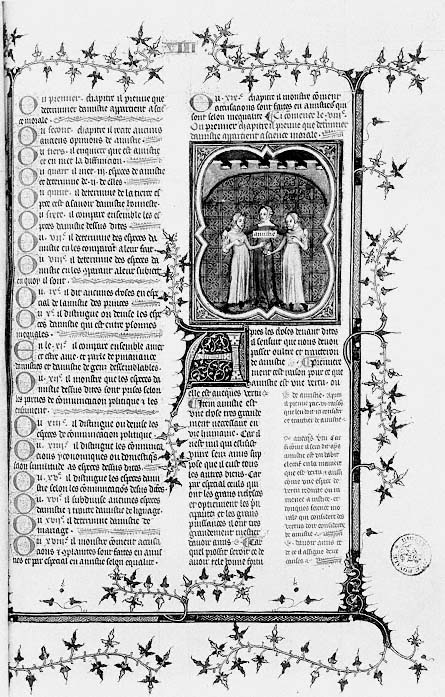
Figure 37
Amistié. Les éthiques d'Aristote, MS A.
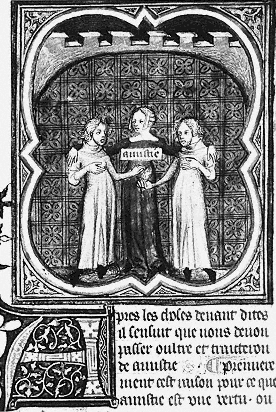
Figure 37A
Detail of Fig. 37
Because of the assimilation of classical ideas of Friendship to medieval thought, it is difficult to determine if the Aristotelian definitions of the term retained a separate identity. Amistié is included in a treatise on the virtues or vices known as the Somme le roi compiled in 1279 for King Philip III by the Dominican Frère Laurent. Amistié (translated alternatively as "Love" or "Friendship") is in this text one of a set of Christian virtues related to gifts of the Holy Ghost and the Beatitudes.[7] In this scheme, Amistié is opposed to Hate (Envie). In one series of Somme le roi illustrations (Fig. 39), Amistié is depicted on the upper left of four scenes as a standing, crowned figure who crushes a dragon and holds a disk containing an image of a bird (probably a dove). The bird is a symbol of love; the dragon, of evil associated with the mouth of Envie.[8] Below Amistié, a depiction of David and Jonathan embracing offers a biblical exemplar of the virtue.
The Amistié illustration in Somme le roi manuscripts, including a copy of 1294 in Charles V's library, apparently constitutes the main medieval figural tradition of depicting Friendship.[9] Written in Paris and dated 1373, a manuscript of a related text known as Le miroir du monde continues this pictorial tradition.[10] The new treatment of Amistié in Figures 37 and 38 suggests that Oresme seeks to define the virtue in specifically Aristotelian terms.
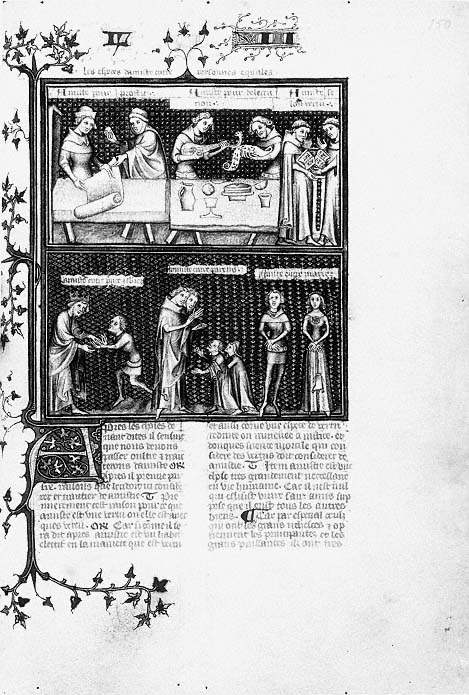
Figure 38
Above, from left : Amistié pour proffit, Amistié pour delectacion , Amistié selonvertu;
below, from left : Amistié entre prince et subiez, Amistié entre parens, Amistié entre
mariez. Les éthiques d'Aristote, MS C.
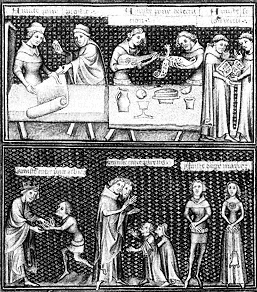
Figure 38A
(left) Detail of Fig. 38
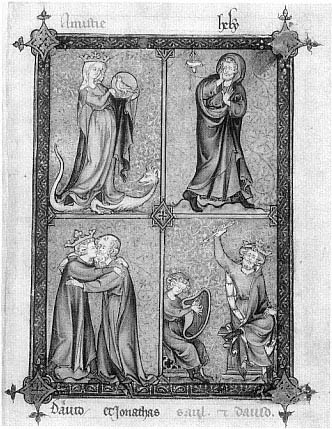
Figure 39
Above, from left : Amistié, Envie; below, from left : David and
Jonathan, Saul and David. Frère Laurent, Somme le roi.
The Personification Allegory in MS A
By way of a subject guide, the illustration introducing Book VIII in A (Figs. 37 and 37a) offers a charming personification allegory. The miniature occurs five lines from the top of the second column of text and gloss on folio 157. Bracketed between the upper right foliate border pointing to the running title and the initial A , Figure 37 follows the chapter headings. The miniature is composed of three symmetrically disposed standing figures placed within a tricolored quadrilobe spanned by an unbroken crenellated wall segment. Figure 37 does not have the frontispiece status of Figure 24, the illustration of Book V. One of four undivided column illustrations in A , Figure 37 and the illustration of Book II (Fig. 11) are the largest and therefore the most important of the column illustrations.[11] Another feature of Figure 37 is a departure from the usual red-white-blue color scheme in favor of a distinctive gray-blue-rose palette. Since these more subdued colors are repeated in the next miniature, which introduces Book IX (Fig. 40), this color harmony may signify the continuity of subject matter between Books VIII and IX.[12]
The configuration of three figures in Figure 37 is unusual as well. The central and largest person is a fashionably coiffed young woman wearing a simple graygreen gown. Her figure lines up with the vertical points of the quadrilobe, the geometric background, and the center of the second column. Although her body is depicted frontally, her head is turned to look at one of two bearded men, who are identically dressed in long rose mantles. Each one turns his head and gestures toward his double. With the other hand, each supports a pink heart. In turn, the female figure extends her disproportionately long arms to embrace the shoulders of the two men. The only inscription in the miniature identifies the woman as Amistié, or Friendship. The position of the inscription at chest level of the personification instead of above her head is unusual. Such a placement may allude to the heart directly below it as the source of the emotions associated with Friendship.
Although Amistié is the sole verbal clue within the miniature, the layout of folio 157 assures the repetition of this key word to guide the reader. In the first column opposite the miniature, the word Amistié occurs in seventeen of the nineteen chapter titles. Chapter 3 is especially important, as the title designates it as the place where the term is defined. Indeed, in the closing gloss of that chapter Oresme explains: "Amistié est benivolence non latente ou manifeste entre pluseurs personnes de l'un a l'autre ou entrechangeable pour aucun bien" (And Friendship is goodwill, which is manifested among people toward one another or given and taken for [mutual] benefit).[13] When the reader moves to the second column of the folio, rubrics above the miniature make the important point that in Chapter 1 Aristotle demonstrates that Friendship belongs to a discussion of "science morale" (moral science). Directly below the illustration, the first paragraph states the necessity of Friendship to human life. With particular relevance for Oresme's primary reader is the declaration that Friendship is essential for the rich and politically powerful.[14] Finally, in the second of three glosses on this folio Oresme makes clear
how Aristotle relates Friendship to virtue.[15] Thus, a variety of introductory verbal information linked to the inscription and miniature on the same folio associates essential concepts with the image.
How does the personification allegory visually express essential aspects of Aristotle's generic definition of Friendship as translated by Oresme? As in the illustrations of Book VII (Figs. 35 and 36), body language is essential in communicating certain points about Amistié. To begin with, the figure's embrace conveys the notion that Friendship depends on reaching beyond the self to someone else. The mutual awareness of Amistié and the two men, conveyed by their turned heads and gazes, indicates their recognition of the bond united by and characteristic of Friendship. Another important element is that the two men support the single rose heart. If in this context the heart symbolizes the soul, the concept expressed may be that the highest type of Friendship symbolizes putting "one soul in two bodies."[16]
Costume again plays an important role in elucidating significant aspects of the concept. For example, the same rose-colored robes worn by the two men, as well as the resemblance of their facial features, hairstyles, and beards, establish that they are identical twins. This kinship metaphor picks out an essential point in Aristotle's definition of Friendship: the similarities between two individuals and the bonds that bind them are summed up in the saying, "A friend is another self." Since the mantles worn by the friends resemble those worn by Le Continent and Le Vertueus in the illustrations for Book VII (Figs. 35 and 36), the allusion here is to Aristotle's highest type of Friendship. Based on virtue, this kind of Friendship has "qualities [which] are alike in both friends," and men are described as "alike in virtue; for these wish well alike to each other qua good, and they are good in themselves."[17] Oresme puts it this way: "Et pour ce dient il un proverbe, que chose semblable aime son semblable et que .i. oysel va a son semblable si comme un estourneau va a un estourneau; et ainsi de quelzconques teles choses" (And for this reason there is a proverb that "like cleaves to like" and that "a bird flocks to its own kind" just as a starling flocks to another starling; and other such things).[18]
The costume and hairdo of Amistié in Figure 37 are those of a contemporary and fashionable young woman, although her mantle lacks the fur trim of the dress worn by Concupiscence in Figure 35. Thus, Amistié does not share the sexual neutrality of Raison or virtues like Attrempance or Sapience conveyed by their widowlike headdresses (Figs. 16, 33, and 34). Nor does she wear the crown that distinguishes the fashionably clad Vertu in Figure 11. The only sign that Amistié represents an elevated spiritual ideal is her height, a mark of her superiority to the twins. Perhaps the lack of a crown or other mark of Amistié's high status was unintentional. Or Oresme may have wished to distinguish Amistié, who is personified by a feminine, transcendent ideal, from the unnamed masculine "Friends," who operate in a different sphere. Although a triadic ordering scheme appears again, as in Figures 11, 16, and 35, the figures surrounding the woman in the middle here are identical, not antithetical.
The prominent emblem of the heart is an apparently extratextual allusion to the ancient notion that the heart is the seat of the soul, the emotions, or of love.
During the Middle Ages, the heart had both secular and religious connotations.[19] In trecento art, a flaming heart is the symbol of Caritas in the figure by Giotto in the Arena Chapel and Ambrogio Lorenzetti's altarpiece in Massa Marittima and his Good Government fresco in the Palazzo Pubblico, Siena.[20] Furthermore, the secular context of heart symbolism in fourteenth-century French art occurs in a group of ivories, probably made in Paris.[21] For example, two mirror cases depict the offering of the heart to a lover.[22] In an illustrated manuscript of the Roman de la rose , the god of love locks up the beloved's heart.[23]
The heart in Figure 37 operates in a secular context, as the hairstyles and costumes of the three figures imply. Although the illustration of Amistié ingeniously conveys many key notions of Aristotle's concept of Friendship, the reading of the image may have presented difficulties to the contemporary reader. An area of possible confusion is the link between the heart, symbol of heterosexual love, and the two males, who are embraced by the female Amistié. Another complication is the double connotation in French of the word ami , as both sexual partner and friend. Thus, ambiguous gender roles may have occasioned a request for a more explicit visual definition than that of the elegant but cryptic personification allegory of Figure 37.
A Detailed Subject Guide of MS C :
The Upper Register
The total revision of the program of Figure 37 in the analogous miniature of C (Figs. 38 and 38a) departs from the adaptation noted in the illustrations of the previous book (Figs. 35, 35a and 36, 36a). There, the addition of a second register in Figure 36 intensifies and deepens the original meaning established in Figure 35. Here, Figure 38 abandons the single visual definition of Amistié in Figure 37 in favor of specific definitions of the word. Without any internal separation by frame or line, Figure 38 accommodates six separate scenes divided equally between the two registers. The expansive setting of the first two scenes gives the upper zone a crowded appearance. The top-heavy effect also results from the disproportionate space reserved for the extensive inscriptions. Because the third scene of the top register is squeezed into a small area, the lack of harmony is even more obvious. As a possible response to these aesthetic defects, the inscriptions in the lower register are shorter, the settings eliminated, and the figures diminished in scale. These changes show the experimental nature of the revised program of C . The challenge of depicting so many different scenes apparently caused difficulty for the illuminator, a less-gifted member of the workshop of the Master of the Coronation of Charles VI than the miniaturist responsible for the illustrations in Books VI and VII (Figs. 34 and 36).
Such uneven aesthetic effects thus result from an expanded and more overtly didactic program. Figure 38 claims a frontispiece status emphasized by its ample dimensions.[24] The carefully written inscription above the border of the upper register identifies the categories to which the subjects depicted below belong: "les especes d'amistié entre personnes equales" (types of relationships among people
of equal rank).[25] The inscription refers to Aristotle's three main types of friendships or associations among people of equal rank discussed in Chapters 4 through 8 of Oresme's translation. The phrase ".iii. especes de amistié" that begins the title for Chapter 4 introduces the reader to the explanation of two of the three types of relationships, those based on usefulness and on pleasure. In Chapter 5 is found the definition of the third, most perfect and lasting, type: Friendship based on virtue and excellence. Once again, left-to-right placement of the three scenes accords with sequence in the text.
The first scene on the upper register is labeled "Amistié pour proffit." The relationship represented depends not so much on affection as on the utility or material gain that such an association brings. Oresme puts it this way: "Et en ceste maniere, ceuls qui aiment pour bien utile, il ne aimment pas les personnes pour elles, mais pour le proffit que ilz en ont ou actendent avoir" (And in this way, those who love in order to gain something of practical value do not love people for themselves, but for the benefit that they get from them or expect to get).[26] The two merchants exchanging goods behind a table exemplify this type of relationship. A piece of cloth unfurled by the figure on the left brings the offer of a gold coin from the other man, who reaches out to feel the merchandise. Oresme explains that love of gain is the bond that holds this association together. The translator cites as an example of such an association "amistié de pelerins" (relationship of pilgrims), which he explains in a gloss: "Il entent de ceulz qui de lointain paÿs vont et communiquent ou conversent ensemble pour marcheandise et pour gaaing" (He means those who from distant countries go and communicate or associate for merchandise and profit).[27]
The second scene depicts "Amistié pour delectacion." The relationship of two young men for the sake of companionship and pleasure is illustrated by the food and drink displayed on a table and the playing and singing of music. The figure on the left plucks a stringed instrument, while his companion holds an unfolded scroll with words and notes written on it. About friendship for pleasure, Oresme says in the text: "Mais l'amistié des joenes gens semble estre plus pour delectacion, car il vivent selon les passions des concupiscences et quierent et poursivent mesmement ce qui leur est delitable selon le temps present" (But the friendship of young people seems to be more for pleasure, for they live according to the passions of concupiscence and they seek out and pursue especially that which gives them immediate pleasure). Food and drink may stand for both the short duration of pleasure and the intense relationships characteristic of young people, whose friendship "ne dure que un seul jour ou moins" (lasts but for one day or less).[28]
The most worthwhile and lasting type of friendship among equals is "Amistié selon vertu." Ironically, the most excellent category of Amistié has been squeezed into the remaining space of the upper register. The compression into a small corner of the third scene, composed of two men who stand facing each other, could indicate that for some reason the illuminator (or the instructions) did not divide the picture space proportionately. The text states that in this type of friendship the affection derives from the good and virtuous character of the parties, as well as from the good or pleasure they derive from the relationship. Because their charac-
ters are good, the friends wish each other well beyond any benefit that accrues from the association. As a result, this kind of relationship is not casual or ephemeral but will endure. Following Aristotle, Oresme notes that such friendship is rare, as few people are good and virtuous.[29] Perhaps this observation—rather than an error of the illuminator—accounts for the small space allotted in Figure 38 to "amistié selon vertu." Such a division of the picture field would reflect not only sequence in the text but also the idea of the prevalence of the first and second types of friendship and the rarity of the third. In any case, the depiction of the good and virtuous friends as tonsured clerics is a deliberate choice. Holding open books that they discuss, the friends exemplify the life of the mind as the lasting source of pleasure and virtue. In the Middle Ages, the intellectual life in monastic or university settings is associated with the clergy.[30] While Oresme may be simply updating and concretizing the ideal of the contemplative life, his choice of clerical figures may reveal his own personal and social identification with such pursuits.
Friendship in MS C :
The Lower Register
Despite an aesthetic ungainliness, the upper register of Figure 38 provides clear visual exemplification of "les especes d'amistié entre personnes equales." But the lower zone contains no equivalent inscription to indicate the different relationships among the three types of associations. Chapters 15 through 17 and other locations explore the topics of "amistiés entre personnes non equales" (types of relationships among persons of unequal rank). As in the upper zone, left-to-right placement of the scenes follows sequence in the text.
The first scene devoted to relationships among persons of unequal rank depicts "Amistié entre prince et subiez" (relationship between prince and subject). This theme would, of course, have especially interested Charles V. The background pattern of tiny fleur-de-lis of the lower register may have signaled the importance of the topics taken up there.[31] Particularly relevant is the depiction of a standing king wearing a gold fleur-de-lis crown. He receives the homage of a kneeling subject, who places his hand within the prince's.[32] In the tenth chapter of Book VIII Oresme mentions and distinguishes among the three types of relationships in which the parties have different roles or obligations "selon superhabondance ou inequalité des personnes" (according to superiority or inequality of the parties).[33] In all of them, one party has greater power or authority than the other. Because of his moral excellence and political authority, the ruler can do more for his subjects than they for him.[34] The scene of the king receiving homage clearly conveys the superior authority of the prince. Similar to the depiction of the virtuous clerics of the upper register, the representation of a medieval ceremony translates Aristotle's concepts to familiar, contemporary contexts. Especially telling are the upright position of the king, identified by his crown, the kneeling posture of the fashionably clad subject, and the hand gestures.
The second type of relationship, represented in the central scene of the lower zone, is "Amistié entre parens" (relationship among kindred). Two standing male figures give orders to two tiny children. The disparity in scale accentuates the
dependence of the latter, while their upturned heads and outstretched arms convey their acquiescence to authority. If the iconographic formula repeats the scheme of the first scene, such a resemblance is appropriate. Following Aristotle, Oresme states that the authority parents exercise over their children is similar to that a king wields over his subjects. Although the text acknowledges the differences between the two types of relationships, the resemblances are great. For example, both the father and the king love their dependents more than their respective dependents love them, since the more powerful are superior to the weaker in virtue and the ability to do good. Oresme's detailed analysis of these relationships in several glosses of Chapter 15 permits a rationalization of the benevolence and superiority of kingly authority based on the model of paternal rule.[35]
Although the language and imagery of the first two scenes of the lower register in Figure 38 stress masculine representations, the third includes a prominent female figure. She is the bride in "Amistié entre mariez." Wearing a gold circlet in her hair and a large brooch on her bodice, she stands frontally with crossed hands. A large, dangling purse may stand for the dowry she brings to the marriage. To her right stands the groom clad in a short doublet and hose. Oresme discusses the association of marriage in Chapter 17, as well as in other locations, such as Chapters 14 and 15. In the former, the marriage relationship is compared to one of the six forms of political association outlined by Aristotle in Chapter 37 and developed more fully in the Politics . If the relationship between a father and son resembles a monarchy in its absolute rule, Friendship between husband and wife is compared to aristocracy. In this regime, the man's preponderant authority rests on the principle of superior virtue and command of affairs appropriate to him, whereas the female has control over certain restricted domestic areas.[36] In Chapter 17 Oresme discusses the relationship between husband and wife as a natural one, and a primary unit in the association of families that makes up the political community. Marriage is also described as a relationship that brings profit and pleasure to both parties. If the characters of husband and wife are both good and just, marriage can also be described as a relationship for the sake of virtue. Of course, Oresme explains in a gloss, the virtues and actions of the husband are different from those of the wife.[37]
The depiction of "Amistié entre mariez" in Figure 38 does not reflect the inequality of status expressed so clearly in the other two scenes of the lower register. Both husband and wife are the same size and stand frontally with hands and feet in identical positions. The failure of the scene to demonstrate superior male status may lie in Oresme's instruction to depict a bride and groom. Limited by constraints of space, such a representation does not permit overt expression of the power relationships between husband and wife or differentiation of their work roles. These distinctions appear in the illustrations to Book I of Oresme's translation of the pseudo-Aristotelian Economics (Figs. 80 and 81).[38] It may also be the case that the disparate roles of man and wife were understood by the contemporary reader and required no visual demonstration.
Thus, the apparently simple scenes of "les especes d'amistié qui sont entre personnes non equales" in the lower register have complex interrelationships to polit-
ical ideas of fundamental importance to Charles V. Compared to the more expansive and detailed scenes of the upper register, the three below are reduced in scale and format. While the fleur-de-lis background and king's crown signal their importance, it is hard to say if the different treatment of the two zones results from pictorial experiment or Oresme's desire to rely in the lower register on his reader's familiarity with the institutions identified. Such a hypothesis may seem paradoxical, but by 1376, when C was completed, Charles V and other influential readers had had the opportunity to familiarize themselves with Oresme's translation of the Politics . Dating from about two years earlier, Charles V's first illustrated copy (B ) of this text may have provided an opportunity for oral explications. If so, Oresme may well have discussed the important analogy between paternal rule and kingship.
In short, the illustrations for Book VIII in A and C (Figs. 37, 37a and 38, 38a) show radically different approaches to the visual definition of Aristotle's concept of Friendship. The former relies on an elegant and subtle personification allegory to communicate profound psychological and social characteristics of Friendship. As a whole, the triadic scheme presents a variation on the man-in-the-middle theme not only in gender but also in representing an embracing ideal rather than a set of contrasts. In comparison, the radical revisions undertaken in Figure 38 attempt far more ambitious visual definitions. Based on Aristotle's insightful division of personal relationships according to the power of one party over another, Oresme's ingenious program represents the most advanced example in C of the subject-guide type. Within their separate representational modes, Figures 37 and 38 conceive sophisticated and contrasting strategies for ordering the two types of visual definitions presented to the readers of Book VIII.